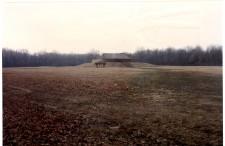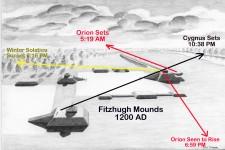
Press Release (ePRNews.com) - Evansville, Indiana - May 04, 2016 (UTC) - One of the most researched “secret” rituals of America’s ancient mound builder culture is the soul’s journey to the Path of Souls. It reveals some of their deepest and most cherished spiritual ideas. These include their ideas about the soul, the afterlife, and the journey after death. All of the rituals in this journey involved magic, specifically the manipulation of sacred symbolic objects employed at specific times and within carefully placed sacred spaces designed for the rituals. The “Path of Souls” is the core belief system of what archaeologists refer to as the “Southeastern Ceremonial Complex” (SECC). It was a journey to the stars.
The magical rituals of the SECC engaged mounds, geometric earthworks, specific symbols, containers, and drugs found in nature combined with movement through the sacred space. The mounds and earthworks often formed the paths for the spirit to follow and also allowed tribal participants in the rituals to perform controlled movement through the sacred space.
The magical rituals of the SECC engaged mounds, geometric earthworks, specific symbols, containers, and drugs found in nature combined with movement through the sacred space. The mounds and earthworks often formed the paths for the spirit to follow and also allowed tribal participants in the rituals to perform controlled movement through the sacred space.
The journey to the sky began when the departing soul leaped over water to a portal in the western sky. The jump to it took place just before dawn on the Winter Solstice. The portal, known as an “ogee,” was in the palm of a hand hanging down in the sky. The hand was formed by the constellation of Orion, and the portal was Orion’s Nebula, Messier-42. The hand with the ogee is known as the “eye-in-hand,” and it is one of the most striking symbols of the SECC.
The soul leaped through this ogee—a slit in the sky—to the Path of Souls (the Milky Way) where it made its way along this vast band of stars slowly moving toward the north. It eventually reached a split in the path formed by the dark rift of the Milky Way. Here, it encountered a large raptor bird—a sky deity, which served as a judge. The bird was formed by the constellation of Cygnus located at the Dark Rift. Symbols of raptor birds and a “forked eye” represent this spot.
In a series of earlier research reports, stellar alignments to the Path of Souls have been found at several Hopewell (1000 BC-200 BC) and Mississippian sites (AD 900-1400). The Path of Souls ritual involves four key alignments of mounds and earthworks to the horizon, all of which are designed to allow observers to view the stellar event from the top of one major mound across another mound or earthwork placed in precise position. It is thought that tall, large wooden posts or temple tops were erected on the mounds to show the spot on the distant horizon where the stellar event took place.
The necessary stellar alignments in the Path of Souls journey appear to be: 1) The place on the horizon where the sun sets on the Winter Solstice; 2) The horizon location where the Cygnus Constellation sets after sunset; 3) The place on the horizon where the Orion Constellation is first seen rising at sunset; and, 4) The location on the horizon where Orion sets just before dawn. One additional stellar element is needed. That is that the Scorpius Constellation (the ruler of the underworld) needed to be below the horizon and not visible when the ceremony took place.
The Angel Mounds site is located by the Ohio River in Evansville, Indiana. It was constructed starting in AD 1000 and was in use until approximately AD 1400. Fourteen mounds were erected at the site, which was encircled by a high, fortified palisade wall enclosing 100 acres. It is thought that about 1000 people lived in the complex with many smaller towns surrounding the town. Five large platform mounds were erected in the complex with the largest, known as Mound A, located in the center of a plaza area. The mound was nearly 30 feet high and had two flat levels, each with temples. Its huge base was 644 feet by 415 feet. As with previous Mississippian sites studied, it is assumed that the central mound was utilized for key stellar alignments. All of the research that follows was conducted by Dr. Greg Little, author of The Illustrated Encyclopedia of Native American Mounds & Earthworks.
Utilizing the computer program Starry Night Pro and the GPS coordinates of the central mound, the key stellar alignments in the Path of Souls concept were checked for the Angel site on the Winter Solstice in A.D. 1100.
The first item checked was the visibility of the Scorpius Constellation on the Winter Solstice night. Results showed that Scorpius was below the horizon the entire night rising only after dawn when it could not be seen. In addition, alignments to the Winter Solstice sunset were calculated. As viewed from the central mound, the sunset would have been viewed directly over Mound F, a large truncated pyramid with a temple erected on its summit.
The next alignments calculated were the visibility and actions of Cygnus. At dusk, Cygnus was visible on the northwest horizon and it fell below the horizon at 11:00 PM. As viewed from the central mound, the setting of Cygnus was directly over Mound E, a conical flattop mound that housed a temple. The final alignments checked were the rising and setting of Orion. At 7:00 PM Orion was seen rising on the eastern horizon over a small mound and was seen directly over the eastern corner of the palisade wall at the Ohio River. It traversed the sky until 5:50 AM when it set slightly southwest directly over Mound C, a large truncated pyramid also housing a temple. Finally, the Ohio River bends sharply to the north due west of Angel Mounds, serving as the body of water where the soul had to wait until the setting of Orion’s Nebula.
Angel Mounds shows the same key Path of Souls’ stellar alignments on the Winter Solstice as the Hopewell sites of Portsmouth and Marietta, Ohio and the Mississippian sites of Winterville, Mississippi and Moundville, Alabama. More sites are expected to do the same, but the question of where and when these ideas developed still remains unanswered. Britain’s Andrew Collins believes that the ideas involved in the death journey may have developed over ten thousand years ago.
Source : ATA-ISRATA-ISR Independent Science Research
PO Box 9025
Memphis, TN 38190
Website: http://www.apmagazine.info



